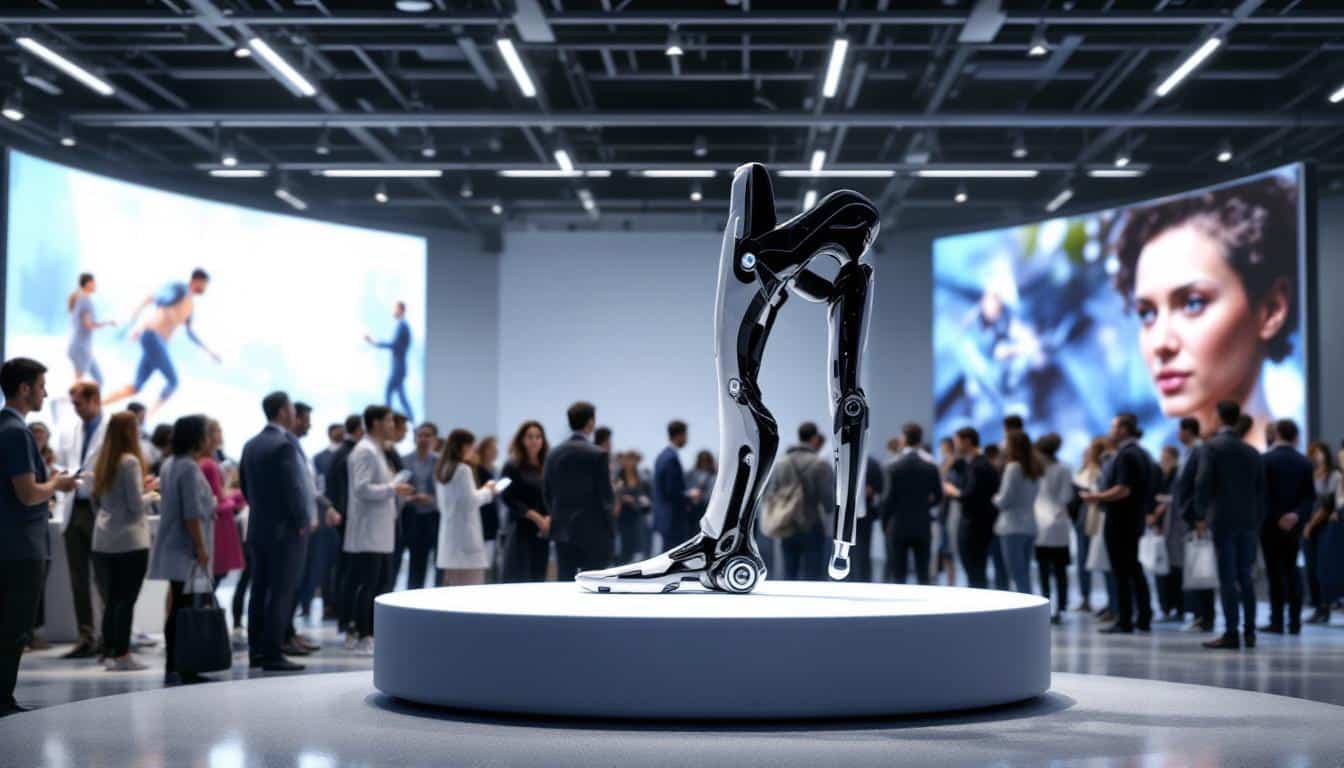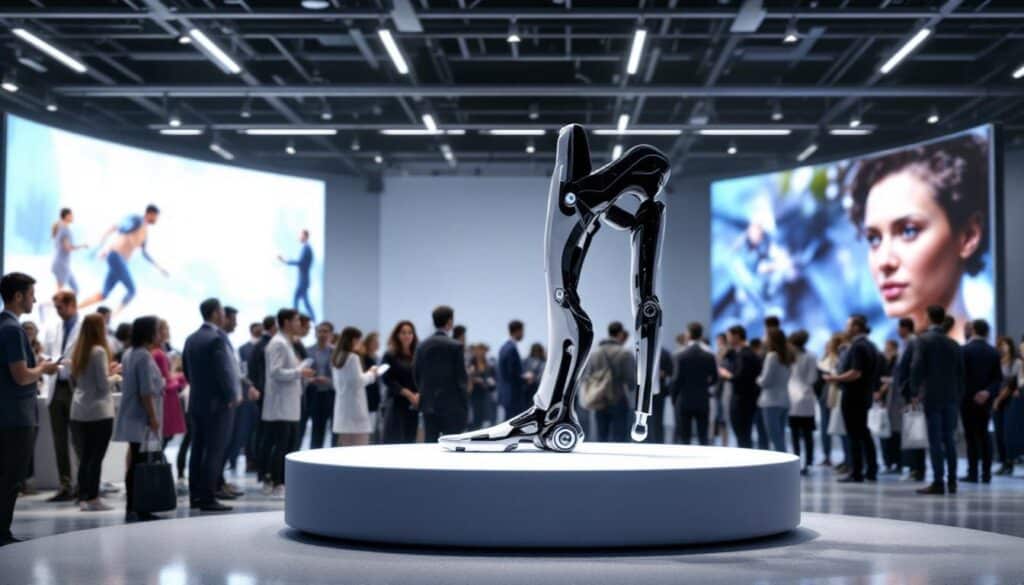“`html
Thousands of people living with partial paralysis of the lower limbs can now access one of the most advanced orthoses in the world: the microprocessor knee-ankle-foot orthosis (MPKAFO).
This progress follows a successful pilot where objective measurements and user feedback showed significant improvements in mobility and quality of life compared to traditional KAFO devices.
Developed by Blatchford, a leader in the manufacturing of advanced prosthetics and orthoses, Tectus represents a major advance for those suffering from partial paralysis of the lower limbs.
With approximately 50,000 people in the UK affected by paralysis, many of whom rely on lower limb orthoses such as KAFO, Tectus has been designed to address the need for a smarter, lighter and more economical orthosis. Utilizing Blatchford’s proprietary Performance Response Technology and an award-winning microprocessor technology, Tectus mimics the natural function of the knee joint. Custom-fitted for KAFO, it incorporates an advanced system of springs, hydraulics, and sensors that allows users to achieve a more natural walking cycle than any other microprocessor-controlled KAFO.
The unique “spring assist” feature uses adjustable control to ensure a full leg extension at the optimal moment, before the heel strikes the ground. This promotes a smoother walking experience and aids in limb symmetry, so the affected leg behaves very similarly to the unaffected limb. Weighing only 660g, Tectus is significantly lighter than other MPKAFOs, providing increased comfort, reduced muscle fatigue, and decreased energy expenditure, which led to a 20% improvement in task completion rates during the pilot.
The device offers several features enhancing usability, including five user activity modes. These modes allow users to effortlessly switch from walking to sitting, adjust their walking speed, and even ascend or descend stairs with the touch of a button. Tectus can be controlled either directly on the module or via a separate remote control. Battery status, step count, and alerts are easily visible at a glance. Additionally, Tectus offers a battery life of 18 hours, fully charges in just two hours, and is rated IP54 water-resistant.
The benefits of Tectus have been demonstrated by pilot users who underwent various gait analyses and walking tests at Blatchford’s state-of-the-art clinic in Basingstoke, as well as a quality of life assessment using the EQ-5D-5L instrument. Participants reported a 42% improvement in mobility and a 40% increase in health-related quality of life compared to their previous orthotic devices. Tests also showed that Tectus improved their ability to walk and stride by 20%, with increased endurance, higher speed, and reduced pain.
Dominic Atta, Chief Orthotist at Blatchford, stated:
“The issue with traditional KAFOs is that they can increase safety and improve function, but they cannot replicate normal walking. They also struggle to handle terrains other than flat, and most position-controlled KAFOs remain locked or unlocked.
“With Tectus, we have applied our world-class prosthetic technology to create a smart orthosis that can adapt to a wide range of demands and activities. This allows our patients to engage more in daily life – for longer periods, at a faster pace, and with less pain.
“The key to this innovation is the hydraulically and spring-assisted knee joint, which, unlike traditional KAFOs, can smoothly transition between locked and unlocked states and bend under control. This allows for fluidity in walking that a locked KAFO simply cannot achieve.
“Our pilot study and the patients involved have demonstrated how Tectus mimics a natural gait and enhances function, and we are thrilled to officially make this revolutionary technology available to anyone looking to regain their mobility and transform their quality of life.”
A pilot user, Alfie Wright, 52, from Basingstoke, recalls:
“When I tried Tectus for the first time, it was simply revolutionary. Suddenly, I regained my freedom – it was the best feeling in the world. From the first day, I cried in the clinic because I hadn’t felt this kind of mobility in 25 years. I was walking like before, and it was amazing.
“With my new bionic leg, there’s nothing I can’t do. I can tackle slopes, walk on grass, navigate cobblestones, and manage stairs with ease – activities that were impossible for me before. Before wearing it, I was just existing, but now I truly live. The improvements in my physical health have also exponentially boosted my mental health.”
Tectus is effective in treating users with a range of conditions, including spinal injuries with lower limb paralysis, neurological conditions resulting in muscle weakness, and orthopedic injuries causing nerve damage. It is designed for teenagers and adults.

The field of medical innovations is experiencing a major breakthrough with the launch of Tectus, the most sophisticated knee-ankle-foot orthosis in the world, developed by Blatchford. This revolutionary device is now available in the UK following a successful pilot, promising significant improvements in mobility and quality of life for users suffering from partial paralysis of the lower limbs.
What is Tectus and why is it revolutionary?
Tectus represents a major technological advance in the field of orthoses for those with partial paralysis of the lower limbs. Designed to mimic the natural functioning of the knee joint, Tectus uses a combination of microprocessor technology, springs, hydraulics, and sensors to provide a more natural, faster, and more comfortable gait than traditional orthoses.
What truly distinguishes Tectus is its ability to adapt to the dynamic needs of users through its proprietary Performance Response Technology. Unlike traditional KAFO, which generally remains in a locked or unlocked state, Tectus can effortlessly transition between these states, providing unparalleled fluidity in walking. This remarkable biomimicry allows users to regain mobility they haven’t experienced in years.
How did the pilot demonstrate the effectiveness of Tectus?
The successful launch of Tectus is based on the impressive results obtained during the pilot conducted in the UK. More than 50,000 people in the UK are affected by lower limb paralysis, many of whom rely on orthoses like KAFO to maintain their mobility. The pilot allowed Tectus to be tested on a diverse group of users, highlighting a range of significant improvements over traditional devices.
Users underwent various gait analyses and walking tests within Blatchford’s cutting-edge clinic in Basingstoke. Through objective measurements and user experience feedback, the results showed a 42% improvement in mobility and a 40% increase in health-related quality of life. Additionally, the ability to walk and step improved by 20%, with increased endurance, optimized speed, and reduced pain experienced.
What are the key benefits of the Tectus orthosis?
The Tectus orthosis is significantly lighter than other MPKAFO, weighing only 660 grams. This lightness translates into a significant increase in comfort, a reduction in muscle fatigue, and a decrease in energy expenditure. These improvements led to a 20% increase in task completion rates during the pilot, including the L Test of Functional Mobility and the 4-square test.
Among Tectus’s many features, five user activity modes allow for intuitive and flexible use. These modes include the ability to easily transition from walking to sitting, adjust walking speed, and manage ascending or descending stairs with the touch of a button. In addition, Tectus includes an integrated module and a separate remote for optimal control. Battery life, step counting, and alerts are easily accessible, while the IP54 water resistance rating and an 18-hour battery life with a full charge in just two hours ensure prolonged and reliable use.
How does Tectus enhance users’ quality of life?
The impact of Tectus on users’ quality of life is profound and multifaceted. Pilot participants reported a 40% improvement in their health-related quality of life, coupled with a 42% increase in their mobility. These improvements are directly related to the enhanced ability to walk more naturally, faster, and more comfortably, as well as a greater sense of confidence and security in their movements.
Alfie Wright, a 52-year-old pilot participant, testifies: “With my new bionic leg, there’s nothing I can’t do. I can tackle slopes, walk on grass, navigate cobblestones, and manage stairs with ease – activities that were previously impossible for me. Before wearing it, I was just existing, but now I truly live. The improvements in my physical health have also boosted my mental health tenfold.”
What is the potential impact of Tectus on the UK market?
With approximately 50,000 people in the UK suffering from lower limb paralysis, Tectus has the potential to transform the landscape of orthoses in the country. By offering a smarter, lighter, and more cost-effective solution than traditional KAFOs, Tectus directly addresses the growing needs of individuals looking to regain their mobility. The accessibility of this device could also stimulate innovation in the medical technology sector, encouraging other manufacturers to invest in similar solutions.
Furthermore, the success of the Tectus pilot could encourage healthcare professionals and medical facilities to quickly adopt this new tool, thereby improving the therapeutic options available to patients. The integration of advanced technologies into orthotic devices could also influence future research and developments in the field, emphasizing biomimicry and adaptive intelligence.
What innovative technologies are integrated into Tectus?
Tectus integrates several technological innovations that set it apart from traditional orthoses. Blatchford’s Performance Response Technology, combined with its award-winning microprocessor technology, enables it to faithfully replicate the natural movement of the knee. The advanced system of springs, hydraulics, and sensors offers a more natural gait and better management of varied terrains due to automatic adjustment of activity modes.
The ‘spring assist’ function
One of Tectus’s unique features is its ‘spring assist’ function, which uses adjustable control to ensure complete leg extension at the optimal moment, before the heel strikes the ground. This feature supports a smoother walking experience and helps maintain limb symmetry, allowing the affected leg to act very similarly to the unaffected one.
This biomimicry is not just about comfort; it’s also about functionality. It allows users to easily adapt to different walking conditions, whether it’s flat surfaces, slopes, or stairs, while reducing muscle fatigue and increasing energy efficiency.
How to access Tectus and who can benefit?
Tectus is designed to meet the needs of a wide range of users suffering from various medical conditions such as spinal injuries, strokes, and other neurological disorders. The orthosis is specifically designed for teenagers and adults, providing a solution that is adaptable and evolving according to the user’s condition.
For healthcare professionals interested in more information about Tectus, additional information is available on Blatchford’s website at: https://www.blatchfordmobility.com/en-gb/tectus/#form. Additionally, the advances of Tectus align with other innovative technologies in the field of orthotics and custom orthotic insoles, as detailed in this article from Global Santé.
Accessing Tectus requires an assessment by a qualified orthotist to ensure that the device is perfectly suited to each user’s specific needs. Once fitted, the orthosis can provide immediate and lasting improvements in mobility and quality of life, radically transforming the way users interact with their everyday environment.
♿ Lors du Challenge Handicap et Technologie, Julia Moreau, étudiante en 2e année #PIS à #Metz a présenté son projet d'#orthèse sur mesure.
— Arts et Métiers – ENSAM (@ArtsetMetiers_) May 30, 2024
🎯 L'objectif ? Optimiser la fabrication et la conception d'orthèses sur mesure en utilisant la technologie de scan 3D et l'impression 3D. pic.twitter.com/AZx1kdtTcL
The launch of Tectus in the UK marks a revolutionary step in the field of advanced orthotics. Following a successful pilot, this microprocessor knee-ankle-foot orthosis (MPKAFO) positions itself as the most innovative solution in the world for individuals suffering from partial paralysis of the lower limbs.
The impressive results from the pilot demonstrated significant improvements in mobility and quality of life for users, far surpassing traditional KAFO devices. By incorporating Blatchford’s proprietary technology, Tectus offers a more natural, quicker, and comfortable gait, while enhancing the confidence and security of wearers.
With a featherweight of just 660 grams, Tectus stands out for its lightness and intelligent design, reducing muscle fatigue and energy expenditure. The multiple activity modes allow for a smooth adaptation to daily needs, whether walking, sitting, or climbing stairs, facilitating a seamless integration into everyday life.
The testimonies from pilot participants, such as Alfie Wright, perfectly illustrate the transformative impact of Tectus. The orthosis’s ability to replicate a natural gait has not only improved their physical mobility but also had a positive effect on their mental well-being, reflecting an overall enhancement in their quality of life.
The launch of Tectus addresses an urgent need for approximately 50,000 people in the UK affected by paralysis, offering a smarter, lighter, and more economical alternative to existing orthoses. By adopting advanced biomimetic technology, Tectus paves the way for a new era of orthotic solutions, where technology and comfort converge to provide greater autonomy and a more fulfilling life for users.
With this introduction to the UK market, Tectus positions itself as a major innovation in the orthotic device sector, promising to sustainably improve the mobility and well-being of individuals with partial paralysis of the lower limbs.









